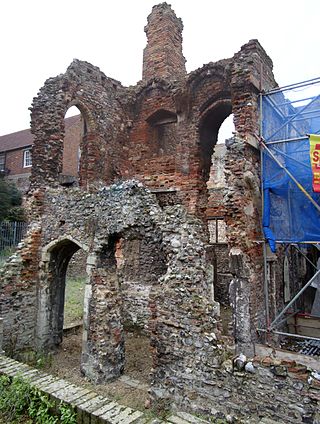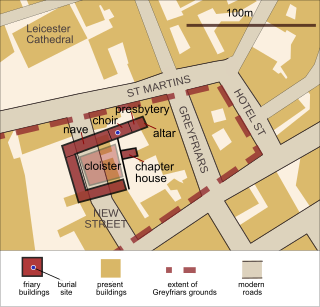
Greyfriars is a country estate in Winchelsea, East Sussex, England. It contains a ruined medieval monastery and church and a 19th-century house.

Greyfriars is a country estate in Winchelsea, East Sussex, England. It contains a ruined medieval monastery and church and a 19th-century house.
A house for the Order of Friars Minor was established in Winchelsea Old Town by 1242. The friary moved to its current location in 1285, after the order purchased 28 acres (11 ha) from John Bone of Wickham, on the site of the new town. [1] It became an important site as Winchelsea flourished as a port in the Middle Ages, but usage declined after the mid-14th century. It was sold during the Dissolution of the Monasteries in 1538 in a state of disrepair, and was used as a barn for some years afterwards. It was listed as a scheduled monument in 1915, and is one of the best surviving instances of Franciscan architecture in England. [1]
The surviving remains include a full-height choir, a portion of the north aisle's east wall, and a section of the south wall. A doorway was added onto the north wall around the 17th century. [1] The friary church's chancel, constructed around 1310–1320, has also partially survived. [2]
The country house was built in 1819 by Richard Stileman in a Gothic style. It replaced an earlier lodging house on the same site. [1] The house is on the southern edge of the town, adjacent to the friary. In the late 20th century, ownership passed to East Sussex County Council who used it as a day care centre, before being sold to private hands in 2000. In 2015, it was put on the market for £4.5 million. [3] It was Grade II listed in 1987. [4]
The house is referred to in a never-finished William Makepeace Thackeray novel as the home of the Weston brothers, a group of highwaymen. [3]

Blackfriars is a restored Grade I listed 13th-century priory in Newcastle upon Tyne, Tyne and Wear, England, located in the city centre, close to the city's Chinatown.

Christ Church Greyfriars, also known as Christ Church Newgate Street, was a church in Newgate Street, opposite St Paul's Cathedral in the City of London. Established as a monastic church in the thirteenth century, it became a parish church after the Dissolution of the Monasteries. Following its destruction in the Great Fire of London of 1666, it was rebuilt to the designs of Sir Christopher Wren. Except for the tower, the church was largely destroyed by bombing during the Second World War. The decision was made not to rebuild the church; the ruins are now a public garden.

Greyfriars Church is an evangelical Anglican church, and former Franciscan friary, in the town centre of Reading in the English county of Berkshire. The church forms part of the Church of England's Diocese of Oxford.

Blackfriars, Gloucester, England, founded about 1239, is one of the most complete surviving Dominican black friaries in England. Now owned by English Heritage and restored in 1960, it is currently leased to Gloucester City Council and used for weddings, concerts, exhibitions, guided tours, filming, educational events and private hires. The former church, since converted into a house, is a Grade I listed building.

Lewes Priory is a part-demolished medieval Cluniac priory in Lewes, East Sussex in the United Kingdom. The ruins have been designated a Grade I listed building.

Greyfriars, in Bristol, England, was a Franciscan friary. The name Greyfriars derived from the grey robes worn by the friars. It was founded at some time before 1234, within the town walls and then moved to Lewin's Mead in 1250. The site included extensive gardens surrounded by a stone wall. Following the Dissolution of the Monasteries in the sixteenth century, the premises were leased to the town council in 1541, who desired to use the stone to make repairs to the town walls, and the harbour facilities. In succeeding centuries many different uses have been made of the site, which is currently occupied by an office block and part of Bristol Dental School.

Various monasteries and other religious houses have existed at various times during the Middle Ages in the city of Exeter, Devon, England.
Rye Austin Friary was an Augustinian friary in Conduit Street, Rye, East Sussex, England.
Blackfriars, Winchelsea, was a Dominican priory in Winchelsea, East Sussex, England. The friary was established in 1318 by Edward II on the outskirts of the new town of Winchelsea, but after several moves to different locations, was granted in 1358 a site of an acre with five adjoining houses in the town centre. It was dissolved in 1538, at which point the building was ruinous. As with other dissolved religious houses in Winchelsea, the stone of the structures was used for the construction of Camber Castle.

Greyfriars, Stamford was a Franciscan friary in Stamford, Lincolnshire, England. It was one of many religious houses suppressed and closed during the Dissolution of the Monasteries in the 16th century. The site is now part of the NHS Stamford and Rutland Hospital.

The Greyfriars, Lincoln was a Franciscan friary in Lincolnshire, England. The surviving building is the remains of the infirmary of the friary, built of dressed stone and brick and dating from c.1230, with mid-19th-century additions. The clay tile roof of the main building is in a poor condition and the Welsh slate roof of the 19th-century extension has been repaired.

Boston Friary refers to any one of four friaries that existed in Boston, Lincolnshire, England.

Great Yarmouth Grey Friary was a Franciscan monastic house in Great Yarmouth, Norfolk, England which was under the Custody of Cambridge.

Greyfriars, King's Lynn was a Franciscan friary in Norfolk, England. The tower, known as Greyfriars Tower survives. It is one of only three surviving Franciscan monastery towers in England and is considered to be the finest. It is a Grade I listed building.

Greyfriars, Dunwich was a Franciscan friary in Dunwich in the English county of Suffolk. The friary was founded before 1277 by Richard FitzJohn and his wife Alice and dissolved in 1538. The original site, which had 20 friars in 1277 when it first appears in records, was threatened by coastal erosion and the friary was moved inland in 1289.

The buildings known as Whitefriars are the surviving fragments of a Carmelite friary founded in 1342 in Coventry, England. All that remains are the eastern cloister walk, a postern gateway in Much Park Street and the foundations of the friary church. It was initially home to a friary until the dissolution of the monasteries. During the 16th century it was owned by John Hales and served as King Henry VIII School, Coventry, before the school moved to St John's Hospital, Coventry. It was home to a workhouse during the 19th century. The buildings are currently used by Herbert Art Gallery and Museum, Coventry.

Greyfriars, Leicester, was a friary of the Order of Friars Minor, commonly known as the Franciscans, established on the west side of Leicester by 1250, and dissolved in 1535. Following dissolution the friary was demolished and the site levelled, subdivided, and developed over the following centuries. The locality has retained the name Greyfriars particularly in the streets named "Grey Friars", and the older "Friar Lane".